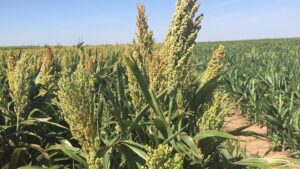Texas A&M researchers believe the development of climate-smart crops is the key to improving nitrogen-use efficiency and reducing fertilizer nitrogen loss in agricultural fields.
The crops would have the ability to suppress soil nitrification and have reduced nitrogen emissions, says Nithya Rajan, Texas A&M AgriLife Research crop physiologist and principal investigator in College Station.
Rajan initiated a project study, “Innovative Sorghum-Based Production Systems with Biological Nitrification Inhibition Property to Enhance Sustainability of Agroecosystems,” funded by a $500,000 grant through the Agriculture and Food Research Initiative, Foundational and Applied Science Program of the U.S. Department of Agriculture, National Institute for Food and Agriculture, USDA-NIFA.
She said nitrification and subsequent denitrification activities promote the loss of nitrogen from agricultural fields and largely is the underlying reason for low nitrogen-use efficiency in most field crops, including sorghum.
“Some plants can suppress nitrification by releasing inhibitors from their roots, a property known as biological nitrification inhibition (BNI),” Rajan says. “This will help with retention of nitrogen for longer periods of time to facilitate its uptake by crops and reduce the loss of nitrogen as nitrous oxide, a powerful greenhouse gas and ozone-depleting substance.”
Initial work supported by another USDA-NIFA exploratory grant involved screening for BNI properties of a range of diverse sorghum genotypes from the program of AgriLife Research sorghum breeder Dr. William Rooney.
This exploratory work was carried out in collaboration with Dr. Guntur Subbarao, principal scientist from the Japan International Research Center for Agricultural Sciences, JIRCAS, in Tsukuba, Japan. Subbarao is a pioneer and world-renowned BNI expert.
“We believe that BNI-enabled crops and production systems are part of innovative solutions for a genetic-mitigation strategy to address problems associated with nitrogen fertilizers in agriculture,” Subbarao says.
Subbarao leads a multi-institutional research group on BNI research in collaboration with several CGIAR institutes including the International Crops Research Institute for the Semi-Arid Tropics, ICRISAT, in Hyderabad, India.
“By collaborating with international institutions such as JIRCAS and ICRISAT that are at the forefront of developing this technology, we can bring innovative solutions to benefit U.S. agriculture,” Rajan says.
The current NIFA project is a collaborative effort by AgriLife Research, Texas A&M Engineering Experiment Station and JIRCAS.
Tackling the project with Rajan are the following Texas A&M researchers in College Station and their specialties: Drs. Sakiko Okumoto, plant physiologist; Ronnie Schnell, agronomist; Jacqueline Aitkenhead-Peterson, urban nutrient and water runoff; Kung-Hui Chu, environmental microbiology; John Jifon, plant physiologist; Muthu Bagavathiannan, weed scientist; as well as Rooney and Subbarao.
They will spend the next two years quantifying and characterizing the BNI compound secretion in sorghum, and evaluating the release of BNI compounds and nitrification inhibition in soils.
“The possibility of BNI in sorghum is exciting and has the potential to fundamentally change the way nitrogen is managed in the future for sorghum as well as other crops,” Schnell says. “Improving nitrogen-use efficiency in grain crops will have substantial economic and environmental benefits for Texas and its farmers. However, there is a lot of research that needs to be done first to develop this technology.”
Beyond identifying elite sorghum cultivars with BNI properties, extensive field testing will be needed to develop cropping systems around this new technology, he said.
“The long-term goal of this program is to develop elite sorghum cultivars with enhanced BNI properties,” Rooney says. “Preliminary evidence indicates that variation exists among sorghum genotypes and it will be possible to improve this trait to have an impact in the future.”












